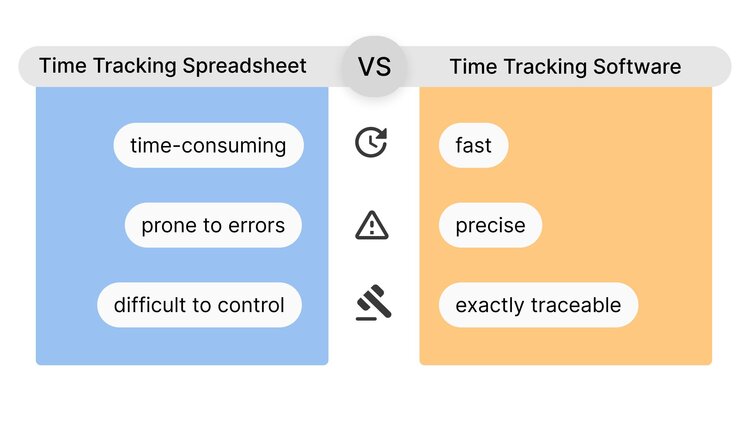Bye-Bye Excel: discover the advantages of a time tracking software
Bye-Bye Excel: discover the advantages of a time tracking software
Yes, you can use Excel to track and calculate working hours, but it is time-consuming and prone to errors. Digital time tracking software offers numerous advantages, such as individual customisation options, ease of use, automatic calculation of working hours and flexibility regarding your working time models. No more cumbersome tables or columns — discover the efficiency of digital time tracking software!

Looking for an Excel timesheet template?
Looking for an Excel timesheet template?
If you ask yourself, “How do I create a time tracking sheet in Excel?” you came to the correct address. We want to challenge your perspective in the next few minutes! In today's digital world, where efficiency and accuracy in time tracking are paramount, Excel is no longer fit for purpose as a time tracking tool. Although Excel has often been used as a free and easy solution for time tracking, it has some serious shortcomings that can affect the success of your business.
The limitations of Excel for time tracking
The limitations of Excel for time tracking
Excel is a popular tool for time tracking, but it has limitations. While Excel can be helpful in many ways, there are several reasons why you may want to consider using a more advanced solution.
Prone to error: first and foremost, Excel requires manual input of data, which can lead to human error. That means that the accuracy of your time-tracking records could be compromised if someone accidentally enters incorrect information or forgets to log their hours altogether. And let's be honest, this could happen to anyone anytime.
Lack of features: Excel lacks automation features such as reminders and notifications when working time or overtime are not tracked correctly. Another limitation with Excel is that it does not provide real-time insights into how much work has been completed at any given moment. That means managers cannot make informed decisions based on current progress towards project goals without manually updating spreadsheets themselves!
No flexibility: “Today, I took a break for forty minutes. However, I was already in the office yesterday by 08:00.” Sounds familiar? — engaging in mental calculations and contemplating what to input into your Excel spreadsheet. Switching to digital time tracking software allows you to be more flexible. Rather than manually entering working hours into Excel afterwards, employees can conveniently track their work hours through their web browser, a clocking in machine or their smartphone app from anywhere and at any given time — be it within the confines of the office, on the go or even while operating remotely from home. It facilitates an adaptable organisation of working schedules that aligns with contemporary demands for flexible work models.
Inadequate data security: saving, printing, collecting, filing spreadsheets — all these actions pose security risks. After all, this is your employees' sensitive data! You must take the necessary measures to ensure adequate data security in your workplace. Failing to do so puts your employees' sensitive information at risk and leaves your company vulnerable to potential legal and financial consequences.
Boosting efficiency with automated time tracking
Boosting efficiency with automated time tracking
Streamline PTO processes with real-time approval workflows. Using spreadsheets for absence management might seem like a cost-effective solution at first glance, but the truth is that they aren't designed to handle complex scheduling needs. With time tracking software, you'll have access to powerful tools for managing leave requests, tracking attendance data and coordinating coverage across multiple teams or departments.
Enhancing accuracy and eliminating human error
Enhancing accuracy and eliminating human error
In today's fast-paced world, accuracy is critical. Whether in the medical field or the financial sector, even a tiny error can have significant consequences. That's why eliminating human error has become an increasingly important goal for businesses and organisations. One solution to this problem is automation.
Automating certain tasks that were previously done by humans, we can significantly reduce the risk of errors. For example, using automated software to perform calculations instead of relying on manual data entry drastically reduces the chance of mistakes.

Facilitating remote work and collaboration
Facilitating remote work and collaboration
Remote work and collaboration have become increasingly significant in today's fast-paced business world. With the rise of technology, it is now possible for employees to work from anywhere in the world while still collaborating effectively with their colleagues. Do you sometimes have second thoughts about remote working? Time tracking transforms your team's trust in each other. A time tracking software allows your team to see what colleagues are working on, and they are on a break or absent. Team communication can be more accessible when workers are given autonomy over managing their time; they tend to be more motivated, resulting in higher-quality output.
Conclusion: Embrace the future of time tracking
Conclusion: Embrace the future of time tracking
In conclusion, there is no denying that time tracking has become an essential tool for businesses of all sizes. With the rise of remote work and flexible schedules, it's more important than ever to have accurate data on how employees spend their time. By embracing the future of time tracking technology, you can streamline your operations and gain valuable insights into productivity levels across your organisation. Whether you implement a simple timesheet system or invest in advanced software with AI capabilities, the benefits will be clear.
So don't hesitate to say goodbye to Excel and welcome a new era of efficiency and productivity with our cutting-edge software!
